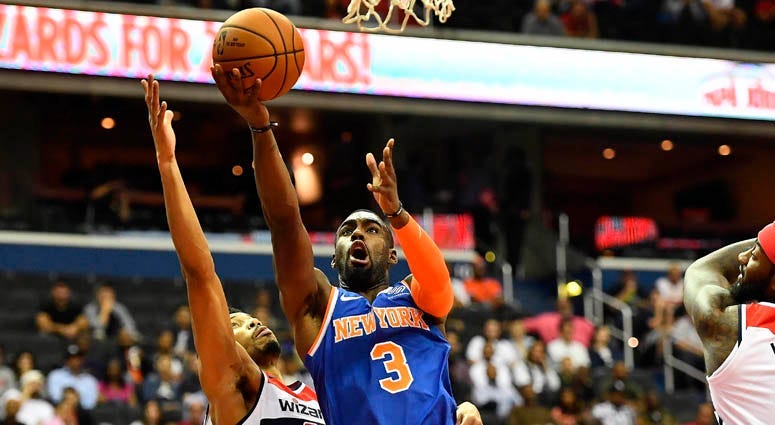
When the Knicks signed Tim Hardaway Jr. last summer to a four-year, $71 million contract, it seemed like a no-win proposition for the franchise. He would either not continue to improve and be a drag on the Knicks' salary cap and/or be just good enough to hurt the team's draft position to prevent it from getting a high lottery position. Nearly one full season in, he has impressively managed to do both.
Hardaway is not a bad player. He is useful and can help a team win a handful of games over the course of a season. What he is not, however, is a player who will significantly move the needle for a team from bad to good. There is a pace to building a franchise, and there are correct times to add certain types of players. But the Knicks got ahead of themselves. A player like Hardaway could be a nice addition for a 48-win team that needs an extra scorer off the bench to get into the top half of their conference. For a good team, Hardaway is, at best, the third-best scorer and either a good bench piece or a low-end starter.
For a team like the Knicks -- who, according to the written word of their own president and general manager, were in a building mode this year -- a $71 million investment in Hardaway never made sense. Even with a healthy Kristaps Porzingis, Hardaway was not good enough to make the Knicks a playoff team. The Knicks were 22-32 when their franchise cornerstone got hurt, ending any real postseason hopes while positioning them for a lower-end lottery seed.
It is literally the worst possible place for a franchise to be. The Knicks are bad enough to be irrelevant and not good enough to have a solid chance of landing a great player in the draft. It is possible, of course. It's just not likely without a lot of luck. Even if Hardaway’s presence meant the difference between a win or loss in just five games this year, the Knicks would be a half game out of the third spot in the lottery. They can add a useful piece selecting ninth, but a foundational star probably won’t be there.
MORE: Schmeelk: NCAA Tournament 2-Round Review For Knicks Prospects
Hardaway’s annual average salary of nearly $18 million also makes it much harder to add difference makers in free agency this summer and next. In the summer of 2019 (depending on Porzingis’ extension), without Hardaway’s contract, the Knicks could have had as little as $40 million of committed salaries. That number could have been even lower if they'd figured out a way to trade Courtney Lee’s salary or stretched Joakim Noah. Now, they will likely have to make both of those moves to have a max slot in the summer of 2019. If you have space for two major free agents, it can be easier to convince them to come as a pair, since two additions might have a much bigger impact to turn a team around than one would.
Relying on free agency to save a franchise is dicey, but those free agent decisions would be added to a team that already has Porzingis, Frank Ntilikina and the Knicks' 2018 and 2019 lottery picks. It would be a young core that might actually be attractive to players depending on Porzingis’ recovery from a torn ACL. There are no guarantees, but there would have certainly been a better chance of taking that next jump than the Knicks' current predicament offers.
Not having that salary spot occupied on the roster would have also given the Knicks the flexibility to take on a short-term salary dump in exchange for a draft pick or young player, the way the Nets did with Timofey Mozgov and DeMarre Carroll. You can make the argument Carroll is just as good as Hardaway right now, if not better (Carroll has a higher player efficiency rating), despite the fact he is older.
That’s what makes the Hardaway contract even more frustrating: He hasn’t continued to improve. His scoring average might be the best of his career at 17.5 points per game, but he has been extremely inefficient and streaky. He is shooting just 42 percent from the field, the second-worst number of his career, and a pathetic 31.5 percent from behind the arc, a career low. He has also set a career high for turnovers, though he gets credit for having his best rebounding and assist numbers of his career.
Hardaway’s stats feel like the perfect example of a player being unable to maintain his level of play when asked to do a little more. He has the highest usage percentage of his career (23.9 percent) and is shooting more than he ever has, which has forced his efficiency numbers into the toilet. His defense is passable but far from upper-echelon. That’s why he seems like more of a sixth man on a good team rather than a true piece on a young team trying to build. At 26 years old, he can still improve, but for a team like the Knicks, his salary would be better used elsewhere.
The Knicks made a mistake with Hardaway, more because of where they are as a franchise rather than the player that he is. He’s had just about the kind of season I thought he would, and for those wanting more, their expectations were probably out of whack. But the Knicks are stuck with him and will feel the pain the next two summers as he eats up their cap space and the team is unable to trade him without taking significant salary back or offering an asset to move him.
The Knicks still haven’t learned their lesson as to how to properly build a franchise, and Tim Hardaway Jr. is a good example of it.
